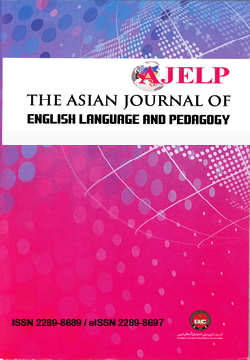Exploring the effectiveness of using L1 in teaching grammar to English as a foreign language learner
Keywords:
Translation in language teaching, teaching grammar, EFL learnersAbstract
There have been many controversies in the history of language education regarding the effectiveness of using students’ mother tongue in the classroom. Some researchers believe that it can cause interference and procrastinate the process of language learning while others believe that it can have educational benefits. The purpose of this study was to examine the effectiveness of using translation in teaching grammar to English as a Foreign Language (EFL) students. 30 EFL students were selected and randomly assigned to two groups, namely control and experimental. To examine the effectiveness of using translation in teaching grammar, the two groups were taught for 18 sessions using two different methods. In the experimental group, students’ L1 was ‘judiciously’ used while teaching the grammatical rules, while in the control group, English language was used as the only language of instruction. After 18 sessions of instruction, the performance of the two groups in the pre-test and posttest were compared using T-test and Mann-Whitney U test. The findings indicated that the experimental group outperformed the control one, which confirmed the positive effect of using translation in teaching grammar to EFL learners. The results were discussed and the pedagogical implications were presented.
Downloads
References
Unpublished Master’s thesis, University of St Mark and St John, UK.
Atkinson, D. (1987). The mother tongue in the classroom: A neglected resource? ELT journal, 41(4), 241-247.
Azizifar, A., Faryadian, E., & Gowhary, H. (2014). The Effect of anxiety on Iranian EFL learners speaking skill. International Research Journal of Applied and Basic Sciences, 8(10), 1747-1754.
Bawcom, L. (2002). Overusing L1 in the classroom. Modern English Teacher, 11(1), 51-53
Chang, S. C. (2011). A contrastive study of grammar translation method and communicative approach in
teaching English grammar. English language teaching, 4(2), 13-24.
Cianflone, E. (2009). L1 use in English courses at university level. ESP World, 8(22), 1-6.
Cohen, A. D., & Brooks‐Carson, A. (2001). Research on direct versus translated writing: Students' strategies and their results. The Modern Language Journal, 85(2), 169-188.
Cook, G. (2007). Unmarked Improvement: Values, Facts, and First Languages. IATEFL Conference, Aberdeen, 18 – 20 April. Retrieved from:
http://www.teachingenglish.org.uk/iatefl2007/jasmina_day2.shtml
Cook, G. (2010). Translation in Language Teaching. Oxford: Oxford University Press.
Cook, V. J. (2001). Using the first language in the classroom. Canadian Modern Language Review, 57(3), 184-206.
Edge, J. (1986). Acquisition disappears in adultery: interaction in the translation class. ELT Journal, 40(2), 121-124.
Fernandez-Guerra, A. (2014). The usefulness of translation in foreign language learning: Students’ Attitudes. International Journal of English Language & Translation Studies, 2(1), 153-170.
Hall, G., & Cook, G. (2012). Own-language use in language teaching and learning. Language teaching, 45(3), 271-308.
Harwood, N. (2010). English language teaching materials: Theory and practice. New York: Cambridge
University Press.
Källkvist, M. (2008). L1-L2 Translation versus No Translation: A Longitudinal Study of Focus-on-FormS within a Meaning-Focused Curriculum. In L. Ortega & H. Byrnes (Eds.). The Longitudinal Study of Advances L2 Capacities (182-202). New York: Routledge.
Koletnik Korosec, M. (2013). Teaching grammar through translation. In In D. Tsagari, & G. Floros,(Ed.), Translation in language teaching and assessment (23-40). Cambridge: Cambridge Scholars Publishing.
Laviosa, S., & Cleverton, V. (2015). Learning by translating: a contrastive methodology for ESP learning and translation. Scripta Manent, 2(1), 3-12.
Laviosa, S. (2014). Translation and language education: Pedagogic approaches explored. Routledge.
Lee, T. (2013). Incorporating translation into the language classroom and its potential impacts upon L2
learners. In D. Tsagari, & G. Floros, (Ed.), Translation in language teaching and assessment (3-18). Cambridge: Cambridge Scholars Publishing.
Lee, J., Schallert, D. L., & Kim, E. (2015). Effects of extensive reading and translation activities on grammar knowledge and attitudes for EFL adolescents. System, 52, 38-50.
Malmkjær, K. (2004). Translation in undergraduate degree programs. Amsterdam and Philadelphia: John Benjamins.
Miles, R. (2004). Evaluating the use of L1 in the English language classroom. Unpublished Master’s thesis. University of Birmingham.
Navidinia, H., Mobaraki, M., & Malekzadeh, F. (2019). Investigating the Effect of Noticing on EFL Students' Speaking Accuracy. International Journal of Instruction, 12, (2), 185-209.
Navidinia, H., Nazarloo, S., Esmaeili, Z. (2018). Using translation in foreign language classrooms: Examining its effectiveness in teaching vocabulary to EFL students. Asian Journal of English Language and Pedagogy, 6, 1-10.
Navidinia, H. & Toushe, E. (2017). Teaching English as a foreign language to students with special needs through intersemiotic translation: An experience with deaf learners. Journal of Special Needs Education, 7, 45-57.
Ostovar-Namaghi, S. A., & Norouzi, S. (2015). Differentiated use of the cross-lingual strategy in foreign language teaching. Sino-US English Teaching, 12(12), 916-926.
Pym, A. (2016). Nineteenth-century discourses on translation in language teaching. Retrieved from:
www.usuaris.tinet.cat/apym/on-line/translation/2016_19th_translation_teaching.pdf
Pym, A. (2018). Where Translation Studies lost the plot: Relations with language teaching. Translation and Translanguaging in Multilingual Contexts, 4 (2), 203-222.
Pym, A., Malmkjær, K., & Gutiérrez, M. (2013). Translation and language learning. Luxembourg: European Commission.
Spahiu, I. (2013). Using native language in ESL classroom. International Journal of English Language & Translation Studies, 1(2), 243.
Titford, C. (1983). Translation for advanced learners. ELT Journal, 37(1), 52-57.
Tsagari, D., and Floros, G. (Eds.). (2013). Translation in language teaching and assessment. Cambridge
Scholars Publishing.
Vaezi, S., & Mirzaei, M. (2007). The effect of using translation from L1 to L2 as a teaching technique on the improvement of EFL learners’ linguistic accuracy–focus on form. Humanising Language Teaching, 9(5), 79-121.
Williams, J. (1999). Learner-generated attention to form. Language Learning, 49(4), 583–625.





